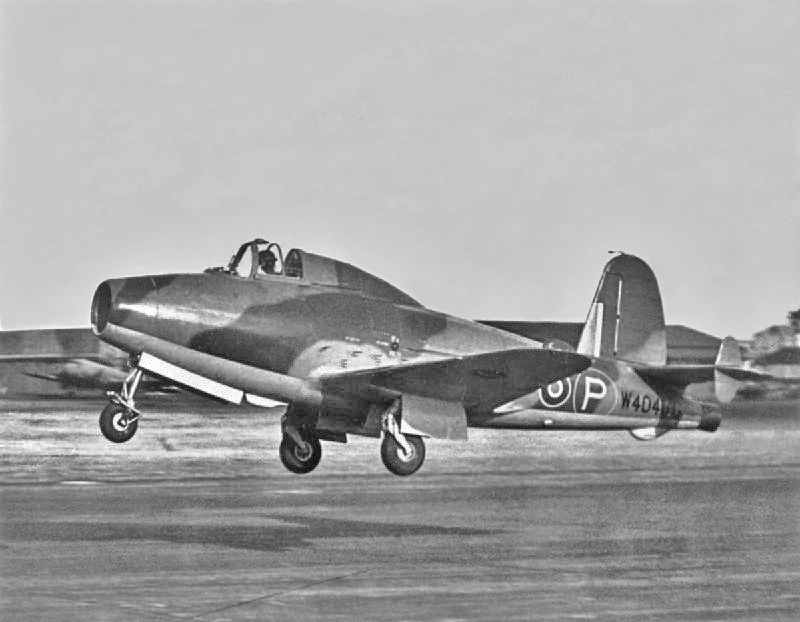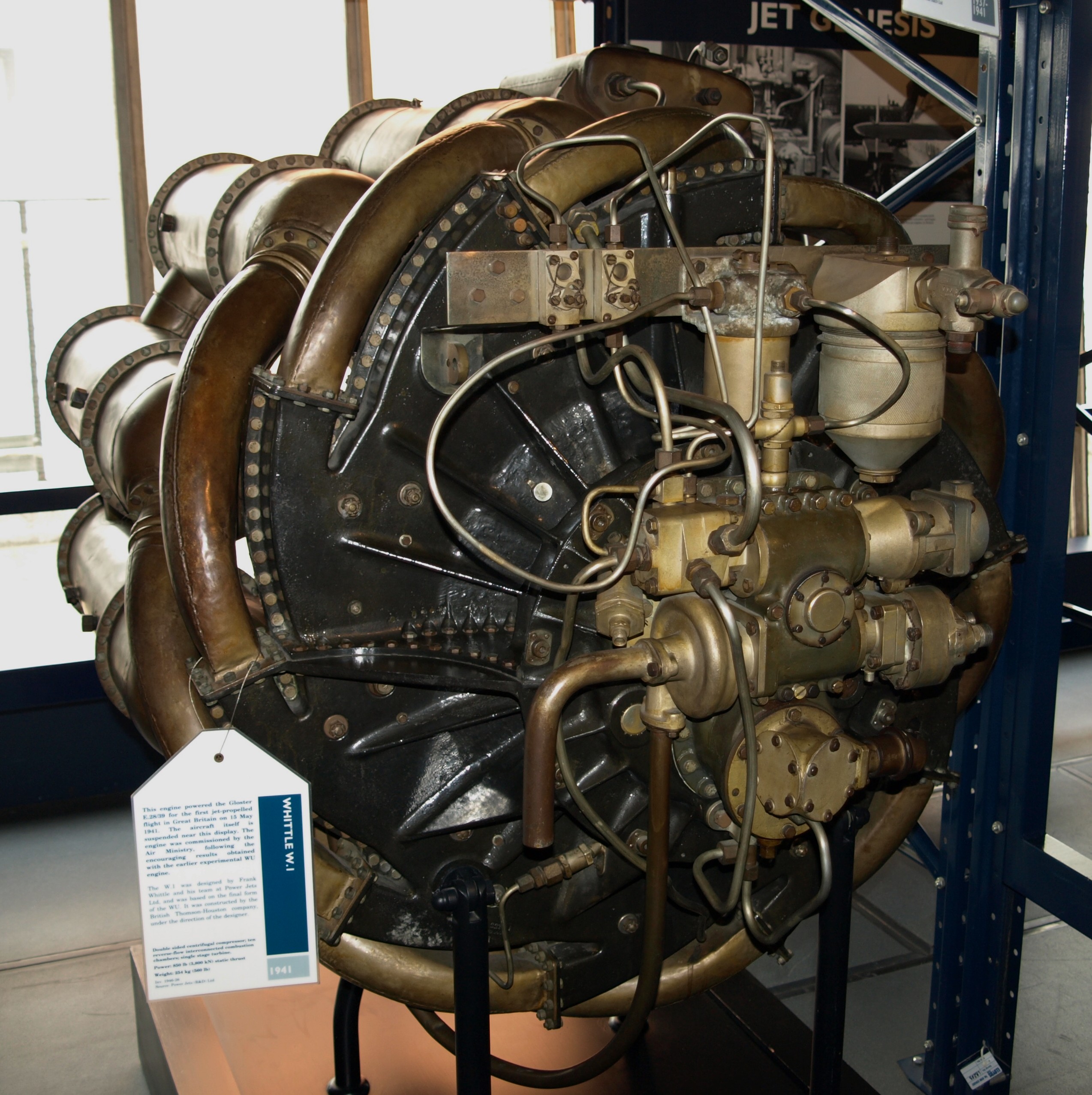Power Jets W.1 on:
[Wikipedia]
[Google]
[Amazon]
The Power Jets W.1 (sometimes called the Whittle W.1) was a British
 At the same time, a contract was placed for a "flight engine", the W.1. Unlike the Whittle WU, that began bench testing in 1937, the W.1 was a symmetrical engine designed to facilitate, after development, installation in an aircraft. The W.1 used a double-sided centrifugal
At the same time, a contract was placed for a "flight engine", the W.1. Unlike the Whittle WU, that began bench testing in 1937, the W.1 was a symmetrical engine designed to facilitate, after development, installation in an aircraft. The W.1 used a double-sided centrifugal

NASM-A19500082000 NASM2016-000437.jpg
NASM-A19500082000 NASM2016-000436.jpg
NASM-A19500082000 NASM2016-000434.jpg
NASM-A19500082000 NASM2016-000439.jpg
NASM-A19500082000 NASM2016-000440.jpg
''Flight'', October 1945 - The Power Jets W.1
{{Power Jets aeroengines W.1 1940s turbojet engines Centrifugal-flow turbojet engines
turbojet
The turbojet is an airbreathing jet engine which is typically used in aircraft. It consists of a gas turbine with a propelling nozzle. The gas turbine has an air inlet which includes inlet guide vanes, a compressor, a combustion chamber, and ...
engine designed by Frank Whittle
Air Commodore Sir Frank Whittle, (1 June 1907 – 8 August 1996) was an English engineer, inventor and Royal Air Force (RAF) air officer. He is credited with co-creating the turbojet engine. A patent was submitted by Maxime Guillaume in 1921 fo ...
and Power Jets. The W.1 was built under contract by British Thomson-Houston
British Thomson-Houston (BTH) was a British engineering and heavy industry, heavy industrial company, based at Rugby, Warwickshire, England. Originally founded to sell products from the Thomson-Houston Electric Company, it soon became a manufac ...
(BTH) in the early 1940s. It is notable for being the first British jet engine to fly, as the "Whittle Supercharger Type W1", powering the Gloster E.28/39 on its maiden flight at RAF Cranwell
Royal Air Force Cranwell or more simply RAF Cranwell is a Royal Air Force List of Royal Air Force stations, station in Lincolnshire, England, close to the village of Cranwell, near Sleaford. Among other functions, it is home to the RAF Colleg ...
on 15 May 1941. The W.1 was superseded by the Power Jets W.2
The Power Jets W.2 was a British turbojet engine designed by Frank Whittle and Power Jets, Power Jets (Research and Development) Ltd. Like the earlier Power Jets W.1, the reverse-flow combustion configuration included a double-sided centrifug ...
.
Design and development
After a period of indifference, in June 1939 a demonstration of the Power Jets WU was made before a delegation of theAir Ministry
The Air Ministry was a department of the Government of the United Kingdom with the responsibility of managing the affairs of the Royal Air Force and civil aviation that existed from 1918 to 1964. It was under the political authority of the ...
, notably Dr
David Pye, Director of Scientific Research. The demonstration was so successful that the Ministry quickly arranged to buy the engine to give Power Jets working capital, lending it back to them for testing.
 At the same time, a contract was placed for a "flight engine", the W.1. Unlike the Whittle WU, that began bench testing in 1937, the W.1 was a symmetrical engine designed to facilitate, after development, installation in an aircraft. The W.1 used a double-sided centrifugal
At the same time, a contract was placed for a "flight engine", the W.1. Unlike the Whittle WU, that began bench testing in 1937, the W.1 was a symmetrical engine designed to facilitate, after development, installation in an aircraft. The W.1 used a double-sided centrifugal compressor
A compressor is a mechanical device that increases the pressure of a gas by reducing its volume. An air compressor is a specific type of gas compressor.
Many compressors can be staged, that is, the gas is compressed several times in steps o ...
of Hiduminium RR.59 alloy, reverse-flow 'Lubbock' combustion chamber
A combustion chamber is part of an internal combustion engine in which the air–fuel ratio, fuel/air mix is burned. For steam engines, the term has also been used for an extension of the Firebox (steam engine), firebox which is used to allow a mo ...
s and a water-cooled axial-flow turbine
A turbine ( or ) (from the Greek , ''tyrbē'', or Latin ''turbo'', meaning vortex) is a rotary mechanical device that extracts energy from a fluid flow and converts it into useful work. The work produced can be used for generating electrical ...
section using 72 blades with 'fir-tree' root fixings; the turbine was later modified to use air-cooling. The turbine blades were of Firth-Vickers ''Rex 78'', a stainless steel developed under Dr. W. H. Hatfield. Design rating was at 16,500 rpm, increased to 17,750 rpm above 4,000 feet. With the W.1 aircraft manoeuvring would subsequently be limited (by compressor-casing stress) to 2 g. Maximum jetpipe temperature was 597 °C.
As development of the new design dragged on, it was decided to build a test unit "early engine" using any components that were deemed unairworthy along with test items. This was assembled to become the one-off W.1X. This officially unairworthy unit powered the Gloster E.28/39 on a short 'hop' during taxiing trials in April 1941, with flight trials taking place a month later with a definitive W.1 engine.
In February 1942, the E.28 was tested with the W.1A engine, reaching a speed of at . For comparison, the Spitfire Mk. V in service at the time had a maximum speed of and the Mk. IX, not yet introduced, mounting an experimental engine reached at high altitude. This purely experimental aircraft and the very first flyable engine outperformed one of the most advanced high-performance aircraft in the world.
After a visit to England in 1941, General Henry H. Arnold
Henry Harley "Hap" Arnold (25 June 1886 – 15 January 1950) was an American General officers in the United States, general officer holding the ranks of General of the Army (United States), General of the Army and later, General of the Ai ...
arranged for the W.1X to be flown to the U.S in October 1941, along with drawings for the more powerful W.2B engine, together with a team from Power Jets. The former became the prototype of first the General Electric I-A and then the General Electric I-16, and by April 1943 the latter had been developed to produce 1,650 pounds thrust (750 kgf).
In 1941, experiments with boosting the W.1's thrust by introducing a liquid coolant were initiated, the first fluid tried being liquid ammonia
Ammonia is an inorganic chemical compound of nitrogen and hydrogen with the chemical formula, formula . A Binary compounds of hydrogen, stable binary hydride and the simplest pnictogen hydride, ammonia is a colourless gas with a distinctive pu ...
which proved too effective, resulting in the engine overspeeding and pushing the thrust and rpm indicators off the scales, before later trials changed to using water, and water-methanol. A system to trial the technique in the E.28/39 was devised but never fitted.
Variants
;W.1(T) :Built from spares for bench-development only. ;W.1(3) :Modified W.1. ;W.1X :Early W.1 built from non-airworthy parts and intended for ground use only (aircrafttaxi
A taxi, also known as a taxicab or simply a cab, is a type of vehicle for hire with a Driving, driver, used by a single passenger or small group of passengers, often for a non-shared ride. A taxicab conveys passengers between locations of thei ...
tests). Later sent to the US in October 1941, becoming the first jet engine to run in North America.
;W.1A
:Based on W.1, 1,450 lbf (6.45KN) air-cooled turbine disc and incorporating features intended for W.2. Used for second series of test flights of E.29/39 ''W4041/G'' beginning on 16 February 1942, and fitted with fuel barostat. Later featured modified oil 'ring main' system to prevent oil freezing at altitude.
;WR.1
:Experimental low-pressure design built by Rolls-Royce
Rolls-Royce (always hyphenated) may refer to:
* Rolls-Royce Limited, a British manufacturer of cars and later aero engines, founded in 1906, now defunct
Automobiles
* Rolls-Royce Motor Cars, the current car manufacturing company incorporated in ...
under contract to Power Jets.
Applications
* Gloster E.28/39Engines on display
The Gloster E.28/39 and the Power Jets W.1 engine that powered it are on public display at theScience Museum, London
The Science Museum is a major museum on Exhibition Road in South Kensington, London. It was founded in 1857 and is one of the city's major tourist attractions, attracting 3.3 million visitors annually in 2019.
Like other publicly funded ...
.
The W.1A is kept at the RAF College Cranwell, and the W.1X at the Smithsonian Institution
The Smithsonian Institution ( ), or simply the Smithsonian, is a group of museums, Education center, education and Research institute, research centers, created by the Federal government of the United States, U.S. government "for the increase a ...
, Washington DC.
Specifications (W.1 early development engine)
Specifications (W.1 later development engine)
Gallery
See also
References
Notes
Bibliography
* * * * *External links
''Flight'', October 1945 - The Power Jets W.1
{{Power Jets aeroengines W.1 1940s turbojet engines Centrifugal-flow turbojet engines